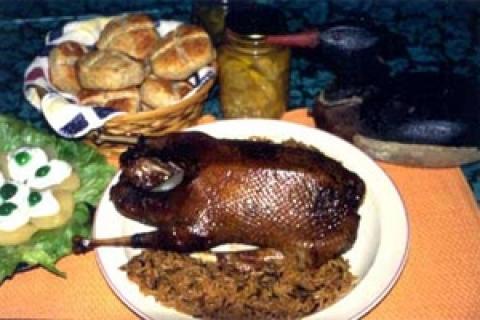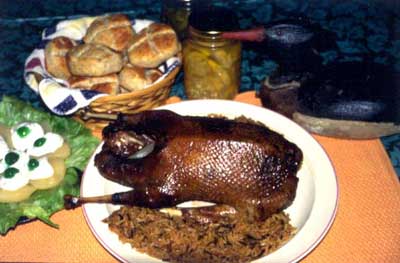
"You take them."
"No, you take them."
"But I took them last time."
"That's OK. Take them anyway."
"I'd rather not."
"But I insist."
"I'll be glad to take them if you all don't want 'em."
"Whaaat?"
 |
| A successful goose hunt provides the makings for some of the most delectable wild game meals you'll ever eat. |
We had just concluded a successful snow goose hunt in the east Arkansas Delta. Seven geese had fallen to our guns, and my hosts were quarreling over who should take them home. They seemed startled when I offered to take the handsome birds.
![]() Tip: Shop Bass Pro Shops for all your hunting gear here
Tip: Shop Bass Pro Shops for all your hunting gear here
"Have you ever eaten a snow goose?" one man asked.
"If not, then let me warn you," said the other. "Snake livers and boiled shoestrings would be infinitely more palatable."
I acted ignorant and insisted on taking the birds off their hands. They seemed pleased, though a bit worried about my state of mind.
That night, I slow-cooked the breasts of two birds in a rich sour cream and mushroom gravy. They were fork-tender and as tasty as the finest rice-field mallard I've ever eaten. The legs, backs, wings and giblets flavored a delectable gumbo. The remaining birds were prepared in a variety of ways -- roasted, grilled, braised, on the rotisserie. They were among the finest game entrees I've ever eaten.
Next time I hunted with my two friends, I let them wheedle me into taking 15 more geese. "My neighbor's hogs will eat them," I said.
I figure what they don't know won't hurt them.
A successful goose hunt provides the makings for some of the most delectable wild game meals you'll ever eat. The dark, richly flavored meat of geese is superb when properly prepared. But if you listen to some hunters, you might wrongfully conclude that snow geese aren't "fittin" to eat.
No doubt, poor field preparation accounts for some hunters' dislike of geese. A goose's body is superbly insulated with feathers and down. So after killing one, it's important that it be quickly drawn and cooled. If it's not, residual body heat may render the meat unfit to eat.
Field dressing is simple. Use a sharp knife to open the body cavity just below the end of the breast bone, then pull out the innards. If you like giblet gravy or gumbo, save the heart, gizzard and/or liver, storing them in a small zip-seal plastic bag. Keep the field-dressed birds in a cool place outside or, better yet, place them on ice in a large cooler.
When the hunt is over, it's time for plucking or skinning. Be aware, however, that federal waterfowl regulations require hunters to leave the head or one feathered wing on each carcass until the bird reaches the "point of consumption," usually your home.
When I plan to cook the birds using dry-heat methods like roasting, I pluck them. Wild geese, unlike their  domestic cousins, have little body fat; the skin flavors the meat and keeps it moist during cooking. Large feathers are plucked from the body, then the bluish pin feathers and down are carefully removed.
domestic cousins, have little body fat; the skin flavors the meat and keeps it moist during cooking. Large feathers are plucked from the body, then the bluish pin feathers and down are carefully removed.
If the geese will be prepared using a moist-heat method of cooking, they can be skinned. Part the feathers along the breastbone, slice the skin from neck to tail, then spread the feathered skin until meat on the breast and legs is exposed. Run a sharp knife along both sides of the breastbone to remove two thick fillets. Then remove the legs and add them to the plastic bag full of gumbo and gravy meat. Wings and back have little meat. Trim away bloodshot flesh, remove any visible shot pellets, and the bird is ready to cook or freeze.
White-fronted geese and Canadas can be field-dressed and prepared in exactly the same manner. Recipes for each are interchangeable, if you take into account the different sizes of the birds and vary cooking time accordingly.
A just-shot snow goose typically weighs 5 1/2 to 6 pounds, with females being slightly smaller than males. When plucked and prepared for cooking, each bird will yield 3 to 3 1/2 pounds of meat for the table, enough to serve two or three hungry hunters. Giant Canadas average 11 to 12 pounds each, Interior Canadas 7 to 9, with smaller races of the bird running 3 to 6 pounds. White-fronted geese average 5 to 6 pounds. The yield of meat is about half the live weight. When roasting, the recommended cooking time is 18 to 20 minutes per pound at 325 degrees.
One bit of advice: Don't expect your hunting buddies to try to pawn Canada geese and white-fronts off on you. The culinary reputation of these birds far exceeds that of their smaller brethren, the snow geese. When it's time to divvy up a brace of Canadas, pleading ignorant won't work to your advantage.
1. Broiled Wild Goose Breast Recipe
- 1 goose breast, skinned and boned (2 fillets)
- 1/2 cup wine vinegar
- 1/4 cup vegetable oil
- 1/4 cup soy sauce
- 1/4 teaspoon freshly ground pepper
- SAUCE:
- 1/4 cup currant jelly
- 1/4 cup water
- 1-1/2 tablespoons Dijon mustard
- 1 teaspoon lemon juice
- 1 teaspoon soy sauce
- 1/2 teaspoon steak sauce
- salt, fresh-ground black pepper to taste
 |
| After you try a few of these recipes, you'll never want to give away another snow goose. |
In a zip-seal plastic bag, combine vinegar, soy sauce, vegetable oil and pepper.Add goose fillets, and allow to marinate 2 1/2 hours, turning often.
Combine sauce ingredients and heat. Remove meat from marinade and place in foil in a broiler pan. Preheat the broiler. Place the fillets 5 inches from heat for 10 minutes of broiling on each side. Place on a wooden carving board and slice each fillet very thinly, diagonally against the grain. Serve the sauce in a gravyboat. Ladle a bit of sauce over each slice of meat.
2. Goose Gumbo Recipe
- 5 pounds goose parts (legs, backs, wings, giblets)
- 1/2 cup vegetable oil
- 1/2 cup all-purpose flour
- 2 cups chopped onion
- 1 cup chopped bell pepper
- 1/2 cup chopped celery
- Salt, black pepper, hot sauce to taste
- 3 quarts hot water
- 1 pint fresh oysters
- 1/2 cup chopped green onion tops
- 1/4 cup chopped parsley
- Cooked rice
Parboil goose parts in water to cover until meat is tender and falling from the bone. Remove from water, cool, and debone.
Make a roux by cooking oil and flour in a big black-iron pot. Cook slowly over low heat until dark-brown, stirring constantly. Add chopped onion, bell pepper and celery, and cook until tender. Add salt, black pepper and hot sauce, then stir in hot water and goose meat. Cook over low heat in a covered pot for 1 hour. Stir in oysters, onion tops and parsley, heat for 10 minutes and serve over rice.
3. Roast Goose with Cranberry Cornbread Stuffing Recipe
- 1 goose, plucked
- 1/4 cup chopped celery
- 2 tablespoons chopped parsley
- 4 tablespoons butter
- 3 cups stale bread crumbs
- 1 cup cornbread crumbs
- 1 teaspoon poultry seasoning
Preheat the oven to 325 degrees. Season the goose inside and out with salt and pepper.
To make the stuffing, cook celery and parsley in butter for five minutes. Blend lightly with the remaining ingredients. Stuff the goose with this mixture, and close the opening.
Place goose breast side up on a rack in a roasting pan. Roast for 20 minutes per pound.
- 50210 views

